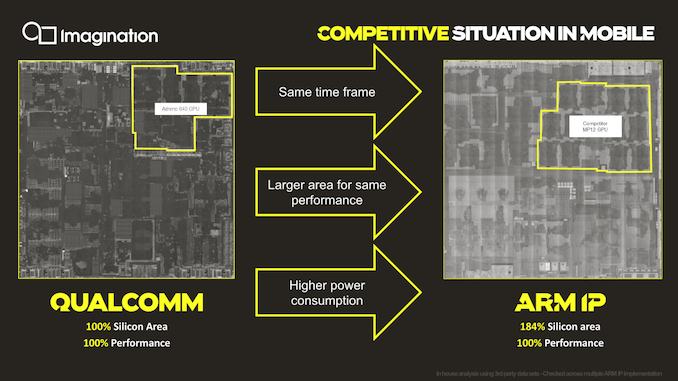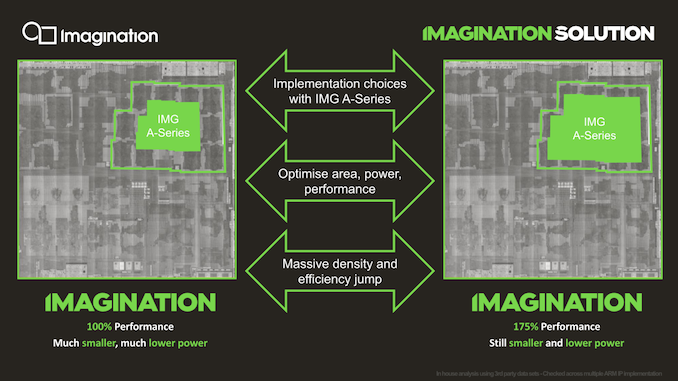Imagination Announces A-Series GPU Architecture: "Most Important Launch in 15 Years"
by Andrei Frumusanu on December 2, 2019 8:00 PM ESTPPA Projections - Significant, If Delivered
Moving on, the A-Series improvements don’t mean much if we can’t put them into context in the competitive landscape.
As mentioned in the introduction, Imagination seem aware of the current PPA deficit that GPU vendor IP offers versus custom designs by more vertically integrated SoC vendors.
Starting off with a comparison between current generation Qualcomm GPU against an Arm GPU. Imagination didn’t specifically mention which designs we’re talking about here, but we do clearly see from the die shots that the SoCs being compared are the Snapdragon 855 and the Exynos 9820.
Here Imagination describes that for a similar performance level, Arm’s Mali GPUs are using ~184% the silicon area compared to Qualcomm’s Adreno implementation.
I do have some doubts about the validity of the comparison being made here, as these SoCs were not made on the same process node – Qualcomm's design is built on TSMC's denser 7nm process, while Samsung's Exynos uses their larger 8nm process. With that in mind, we take the metrics presented with a huge grain of salt as Imagination does say the figures are based on analysis of multiple Arm IP implementations rather than a single data-point.
Projecting the A-Series against a current Mali-G76 implementation, targeting a performance level equivalent to current generation flagship implementations (~100fps in Manhattan 3.0), an A-Series GPU would achieve a significantly smaller GPU implementation requiring much less die area. The comparison implementation here would be an AXT-16-512 implementation running at slightly lower than nominal clock and voltage (in order to match the performance).
If a customer were to choose to use more die area to go wider and slower in clock (more efficient), while still maintaining an estimated area that would be smaller than a Mali GPU, it would roughly achieve a 75% performance advantage. The comparison here would be an AXT-32-1024 running quite far below nominal, giving it a large power efficiency advantage.
Of course, Imagination’s comparison here were made against the current generation Qualcomm and Arm GPUs, which aren't what it'll actually be competing against. Instead, by the time A-series SoCs ship, it will be competing against the next-generation Adreno as well as Mali-G77. We know Arm’s promised goals for the G77 and the improvements in performance per mm² and performance perf/W is around 1.2-1.4x, which we could generalize to 1.3x. Samsung’s upcoming Exynos 990 only promises a 20% performance increase, which is slightly below this projection. On the Qualcomm side and the upcoming Adreno generation, we’ll have to wait a few more days to be able to talk about details, but generally we expect improvements in the same ballpark.
Fortunately for Imagination, the projected PPA figures and advantages for the A-Series are high enough that they would still be notably ahead of both Qualcomm and Arm’s upcoming next generation GPUs, keeping a comfortable lead in either GPU area, or performance, depending on the configuration.
So far everything looks quite splendid – what remains to be seen if Imagination and their licensees are able to deliver on the projected figures.












143 Comments
View All Comments
s.yu - Wednesday, December 4, 2019 - link
No, on the contrary it's reason that Cambricon has to let them if they do.Note the recent 251 incident in which the Party went all-out for 3 days censoring everything trying to suppress the incident, but ultimately failed and they pulled back, and now Huawei for once shows its true colors to the people.
ksec - Tuesday, December 3, 2019 - link
As mentioned by the poster below, I think they are likely to be bought rather than doing well.If you look at the High to Mid End Smartphone, they are dominated by Apple, Samsung, Huawei all using their own Silicon or Qualcomm chip. Which leaves the low end with Mediatek.
Now the low end market only cares about cost, so ARM is actually a better choice due to IP bundling listening.
So I am not too optimistic, and it is also worth mentioning. For anyone who was old enough to remember what the Golden Era of GPU, there were always a new design that claims to be better on paper, and what happened?
Drivers - It is the software. The single biggest unmentioned roadblock to GPU computing. How to efficiently use the hardware is the key. S3, Matrox... and lots of others, remember those?
If I reading correctly this design put even more importance to drivers.
adriaaaaan - Tuesday, December 3, 2019 - link
Thats definitely true but the Vulkan API actually takes away a lot of the driver aspect from the equation. Thats the reasons it exists on so many platforms, because it doesn't depend on the os quite so muchmode_13h - Wednesday, December 4, 2019 - link
Huawei uses Mali GPUs, right? So, once they drop ARM CPU cores and go with a Chinese RISC-V core, they're gonna need a different GPU supplier. Hence, Imagination.In fact, had Apple not dropped Imagination, I wonder if Verisilicon wouldn't still be pumping Vivante's IP.
ET - Wednesday, December 4, 2019 - link
Matrox is still around. Not doing anything on the 3D chip front, but still using its own ASICs for 2D, far as I understand. Using AMD for 3D.VIA, who bought S3, are still around, but I don't know if its newer CPUs include custom made GPUs.
> there were always a new design that claims to be better on paper, and what happened?
Most of them were also better in practice. Though most of them had drawback. It was quite an interesting time. APIs were quite a problem then, and the limited amount of stuff one could do in hardware, but it definitely was an era of growth.
mode_13h - Wednesday, December 4, 2019 - link
Well, if you're going to stretch that far, you might as well also cite Intel.Threska - Wednesday, December 4, 2019 - link
PowerVR (NEC) in a console as well as a PC part.vladx - Wednesday, December 4, 2019 - link
You just ignored that MediaTek just re-entered the high-end SoC market. Or most likely, if you didn't even bother reading the article.ph00ny - Monday, December 2, 2019 - link
Everyone keeps saying if they bring it out. How does a fabless GPU designing firm like imagination "bring it out"?shabby - Monday, December 2, 2019 - link
They use their... imagination 😂